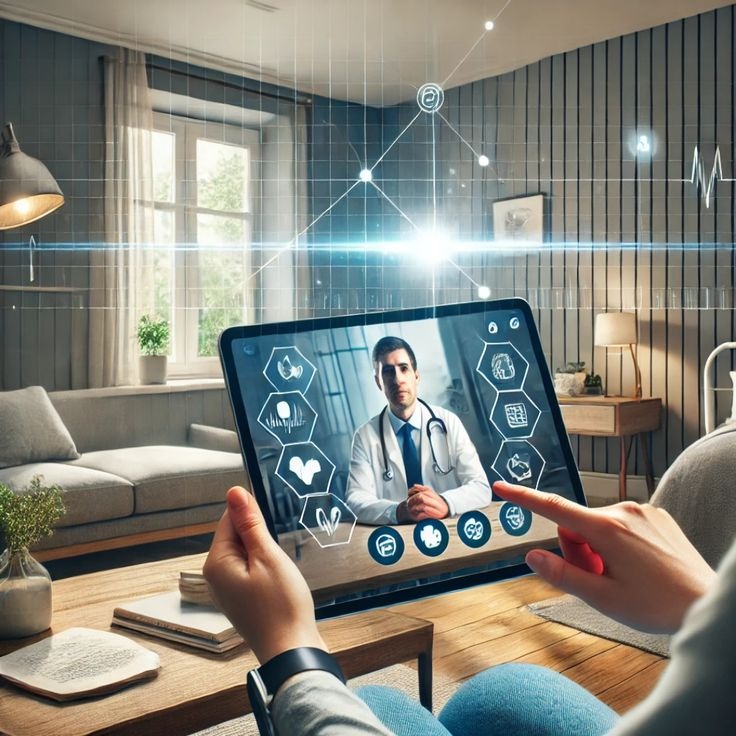Wired for Wellness: The New Age of Digital Healthcare 1st Part

About Course
Course Curriculum
Overview Of E Health
-
Revolutionizing Healthcare: The Impact of E-Health on Access, Quality, and Patient Empowerment
19:16 -
Quiz
E Health And Healthcare Delivery
-
E Health And Healthcare Delivery Part 1 – Revolutionizing Healthcare Delivery: The Role of Technology in Access, Patient Engagement, and Efficiency Improvements
11:36 -
Quiz
-
E Health And Healthcare Delivery Part 2 – Integrating Technology in Healthcare: Enhancing Patient Care, Access, and Reducing Costs Through Innovative Solutions
09:50 -
Quiz
-
E Health And Healthcare Delivery Part 3 – Transforming Healthcare: The Impact of Digital Health Tools Across Hospitals, Clinics, and Home Care Settings
12:35 -
Quiz
Telemedicine
-
Scope and Applications of E-Health – Exploring E-Health: Telemedicine, Mobile Health, E-Prescribing, and Electronic Health Records Transforming Healthcare Delivery
17:20 -
Quiz
-
Telemedicine Part 1 Understanding Telemedicine: Definitions, Evolution, and Key Features of Remote Healthcare Services
13:06 -
Quiz
-
Telemedicine Part 2 – Understanding Telemedicine’s Role in Primary, Secondary, and Tertiary Healthcare for Improved Patient Outcomes and Access
09:28 -
Quiz
-
Telemedicine Part 3 – Real-Life Case Studies: Telemedicine Success Stories
10:36 -
Quiz
-
Telemedicine Part 4 – Patient Privacy and Confidentiality in Virtual Care
06:10 -
Quiz
-
Telemedicine Part 5 – Regulatory Frameworks: National and International Standards in Telemedicine
15:00 -
Quiz
-
Telemedicine Part 6 – Understanding the Essential Technology Infrastructure for Effective Telemedicine Delivery and Patient-Provider Communication
07:46 -
Quiz
-
Telemedicine Part 7 – Choosing the Right Telemedicine Platform: Key Factors for Healthcare Providers and Organizations
07:03 -
Quiz
-
Telemedicine Part 8 – Communication Skills in Telemedicine
05:58 -
Quiz
-
Telemedicine Part 9 – Telemedicine Workflow Management
08:09 -
Quiz
-
Telemedicine Part 10 – Clinical Guidelines and Protocols for Telemedicine
07:36 -
Quiz
-
Telemedicine Part 11 – Telemedicine Implementation: Compliance, Adoption, and Future Trends
10:32 -
Quiz
Mobile Health
-
Mobile Health part 1 – An Overview of Mobile Health: Definitions, Applications, Benefits, and Challenges in Modern Healthcare Delivery
15:06 -
Quiz
-
Mobile Health Part 2 – The Role of Mobile Health in Early Disease Detection, Public Health Surveillance, and Promoting Health Equity
10:21 -
Quiz
-
Mobile Health Part 3 – Exploring Mobile Health Apps for Mental Well-being, Chronic Disease Management, and Telemedicine Solutions
11:38 -
Quiz
-
Mobile Health Part 4 – Wearables for Managing Chronic Conditions
17:33 -
Quiz
-
Mobile Health Part 5 – Clinical Applications of mHealth
10:44 -
Quiz
-
Mobile Health Part 6 – Data Management and Security in mHealth
11:10 -
Quiz
-
Mobile Health Part 7 – Mobile Health Interventions and Behavioral Change
06:55 -
Quiz
-
Mobile Health Part 8 – Mobile Health Solutions for Mental Well-being: Tools, Apps, and Strategies for Managing Anxiety, Depression, and Stress
07:49 -
Quiz
-
Mobile Health Part 9 – Enhancing EHR/EMR Systems with Mobile Health Data for Improved Patient Care and Clinical Decision Support
07:22 -
Quiz
-
Mobile Health Part 10 – Mobile Health Solutions: Bridging Healthcare Gaps in Remote and Rural Communities Through Accessible and Innovative Technology
10:09 -
Quiz
-
Mobile Health Part 11 – Legal and Ethical Challenges in Mobile Health: Ensuring Patient Consent, Data Privacy, and Accessibility in Healthcare Systems
10:43 -
Quiz
-
Mobile Health Part 12 – Training Healthcare Providers on M Health Tools for Enhanced Patient Care and Effective Clinical Decision Making
05:29 -
Quiz
-
Mobile Health Part 13 – Best Practices for Training Health Care Providers
16:08 -
Quiz
-
Evidence Base for Integrating Mobile Health – Integrating Mobile Health Apps into Clinical Care: Enhancing Patient Engagement and Support for Health Management
05:26 -
Quiz
Patient-Centric Care in the Digital Age
-
AI’s Transformative Role in Medicine: Enhancing Diagnosis and Treatment Through Advanced Technology and Personalized Medicine.
09:41 -
Quiz
-
Patient-Centric Care in the Digital Age 1 – Understanding Patient-Centric Care: Principles, Evolution to Digital Systems, and Importance in Modern Healthcare Practices
20:18 -
Quiz
-
Patient-Centric Care in the Digital Age 2 – Enhancing Patient Autonomy and Care Through Remote Monitoring and Virtual Health Platforms in Modern Healthcare
18:44 -
Patient-Centric Care in the Digital Age 3 – Empowering Health Care Professionals: Driving Innovation and Ethical Practices in Patient-Centric Digital Health Solutions
12:45
Post Test & Activity Evaluation
-
Post Test
-
Activity Evaluation
-
How to Download Course Completion Certificate
01:24
Student Ratings & Reviews

Welcome Message
Step into the future of healthcare with our E-Health course — your gateway to mastering telemedicine, digital records, AI, and smart health tools that are transforming care delivery. Learn how to boost patient outcomes, cut costs, and streamline services in clinics, hospitals, and beyond.
Training needs
This course is designed for healthcare professionals, administrators, policymakers, and IT specialists in healthcare. The training addresses the following key needs:
- ✅ Misunderstanding of E-Health Applications and knowledge of EHRs, telemedicine, and health data analytics.
- ✅ Lack of learning how to implement and use mHealth apps, remote patient monitoring tools, and AI-driven diagnostics.
- ✅ Lack of Utilizing digital tools to enhance clinical workflows and patient engagement and access.
- ✅ Misunderstanding of HIPAA, GDPR, and international telemedicine regulations.
- ✅ Lack of exploring cost-reduction strategies and automation in healthcare administration.
- ✅ Limited access to mHealth applications to enhance patient engagement.
Smart Goals
Educate healthcare professionals on the fundamentals of E-Health technologies and their applications in patient care.
Discuss key challenges in E-Health adoption and train participants in solutions.
Focus on technologies and regulatory frameworks currently in use in healthcare systems globally.
Measure effectiveness within three months of course completion through follow-up assessments and case study reports.
Focus on E-Health solutions already adopted in major healthcare institutions to ensure real-world application.
Expand the use of telemedicine to improve healthcare accessibility and patient outcomes by integrating AI, remote monitoring, and wearable technologies.
Implement the upgraded infrastructure and complete training for healthcare providers within one year.””
Discuss a secure, compliant, and user-friendly telemedicine platform tailored to the healthcare provider’s needs.
Assess the effectiveness of mHealth adoption and patient health improvements over a five-year period
Implement and evaluate telemedicine expansion over the next 12 months, with quarterly progress assessments.
Implement telemedicine solutions to enhance primary, secondary, and tertiary care, focusing on chronic disease management and emergency response.
Enhance data security measures in mHealth applications to protect patient information from unauthorized access and breaches.
Train healthcare professionals on telemedicine best practices, invest in secure and interoperable platforms, and promote patient adoption through awareness campaigns.
“”Establish secure telemedicine platforms, train healthcare providers on telemedicine laws and ethics, and create public awareness programs about the benefits and limitations of telemedicine.
Evaluate improvements over a 12-month period, with quarterly assessments on compliance, accessibility, and patient satisfaction.””
“”Evaluate progress over 12 months, with quarterly assessments on security enhancements and compliance rates.
Ensure data privacy and compliance with regulations is essential to maintain trust and protect patient information.””
“”Establish a standardized and legally compliant informed consent process for telemedicine services across various jurisdictions.
Implement multilingual digital consent forms, integrate AI-driven interactive explanations, and provide training for healthcare providers on informed consent procedures.
Integrate cloud-based solutions, AI-driven diagnostics, and user-friendly patient interfaces to enhance accessibility and reliability.
Partner with technology providers to integrate cloud-based solutions, AI-driven diagnostics, and user-friendly patient interfaces to enhance accessibility and reliability.
Explain platform selection and training within three months, followed by full implementation within six months.
Achieve at least 90% patient satisfaction regarding communication quality in telemedicine consultations within six months based on post-consultation surveys.
Conduct monthly training sessions on telemedicine communication, cultural competence, and patient engagement.
Implement training and feedback mechanisms within three months, followed by evaluation after six months.””
“”Streamline telemedicine workflow by optimizing scheduling, documentation, and EHR integration to reduce administrative workload.
Implement automated appointment reminders, pre-visit forms, and seamless EHR synchronization within three months
Assess workflow improvements through staff and patient feedback after six months and adjust strategies accordingly.””
“”Evaluate the effectiveness of implemented protocols through provider feedback and patient satisfaction surveys within six months.
Develop and implement a standardized clinical protocol for telemedicine consultations to ensure patient safety and regulatory compliance.
“”Improve telemedicine compliance, security, and patient engagement by training healthcare staff and optimizing technology adoption.
Implement structured training on telemedicine regulations, integrate telehealth platforms with EHRs, and offer incentives for staff engagement.””
Implement government and healthcare initiatives that promote mHealth applications for disease tracking, vaccination reminders, and chronic disease management.
Assess the impact of wearables and mHealth apps on patient health outcomes over a five-year period.
Improve health outcomes by using real-time data from wearables and mHealth apps to enhance disease management and preventive care.””
Enhance patient health outcomes by enabling continuous monitoring, early detection of complications, and improved medication adherence.
Assess patient outcomes and technology adoption rates over a five-year period.””
Enhance patient care and clinical outcomes through the implementation of mHealth solutions for chronic disease management, maternal health, and telemedicine integration.
Conduct periodic security audits and training sessions every six months to improve data management and security over the next three years.””
Enhance the adoption of mHealth interventions for behavior change, focusing on smoking cessation, weight management, and disease prevention.
Achieve measurable improvements in health behavior metrics (e.g., weight loss, smoking reduction) within six months to one year.
Outcomes
By the end of this course, participants will:
- 🎯 Understand and apply E-Health technologies in real-world healthcare settings.
- 🎯 Enhance decision-making, workflow efficiency, and patient-centered care through digital tools.
- 🎯 Utilize telemedicine, remote monitoring, and AI to improve healthcare accessibility and quality.
- 🎯 Implement best practices for data protection, cybersecurity, and ethical use of digital health tools.
- 🎯 Lead the adoption of smart healthcare solutions, predictive analytics, and mobile health platforms.
- 🎯Learn how the strong evidence base positively impacts the successful implementation of digital health technology into standard patient treatment.
-
LevelAll Levels
-
Total Enrolled111
-
Duration6 hours 20 minutes
-
Last UpdatedJune 13, 2025
-
CertificateCertificate of completion
A course by
Team
Instructor:

Dr.Bassant Ali
DBA, MBA
Voice Over :

Walid Naga
Instructional Designer:

Dr.Mohamoud Samy

Nesma Mohamed
Scientific Committe:

Dr.Bassant Ali

Dr. Ahmed Rashad

